How does this pollination stuff work anyway?
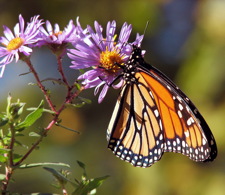 The nursery trade contains a lot of conflicting information regarding plant
pollination.
Credible sources contradict each other and it can leave your head spinning.
One catalog will tell you that
a certain tree is self-pollinating, another will tell you that you need to
plant at least two. We feel
that this is a reflection of a simple concept: nature doesn’t walk a
straight line. Some technically
self-fertile plants don’t do so well setting fruit alone; other
supposedly self-infertile plants
set fruit heavily even when they are apparently isolated from their buddies.
Then you add soil types,
weather, cultural practices… oh my. Isn’t it good to be reminded
of how little we really
understand about nature?
The nursery trade contains a lot of conflicting information regarding plant
pollination.
Credible sources contradict each other and it can leave your head spinning.
One catalog will tell you that
a certain tree is self-pollinating, another will tell you that you need to
plant at least two. We feel
that this is a reflection of a simple concept: nature doesn’t walk a
straight line. Some technically
self-fertile plants don’t do so well setting fruit alone; other
supposedly self-infertile plants
set fruit heavily even when they are apparently isolated from their buddies.
Then you add soil types,
weather, cultural practices… oh my. Isn’t it good to be reminded
of how little we really
understand about nature?
Our catalog notes about pollination requirements for each plant are primarily based on our own observations and info we’ve gleaned from the experts. When there is any doubt, we suggest multiple plantings to ensure fruit sets. Here are a few definitions to help shed light on some commonly used botanical terms
Self-pollinating, self-fertile and self-fruitful all mean the same thing. You can plant a self-fertile tree and expect it to pollinate itself and set fruit alone (for example, peaches, pie cherries, apricots). However, many self-fertile trees’ fruit sets are enhanced with multiple plantings (elderberries and amelanchiers).
Self-sterile or self-infertile means that another tree of a different cultivar or variety is needed to set fruit (cross-pollinate). This is the case with most apples.
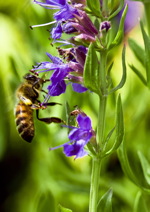 Monoecious (from Greek meaning ‘one
household’) plants have their female
and male parts on separate flowers both together on the same plant. In most
cases, these plants are
self-fertile, but not always! (Black walnuts are monoecious but the male
flower releases pollen before
the female flowers open, so having two plants is better than one).
Monoecious (from Greek meaning ‘one
household’) plants have their female
and male parts on separate flowers both together on the same plant. In most
cases, these plants are
self-fertile, but not always! (Black walnuts are monoecious but the male
flower releases pollen before
the female flowers open, so having two plants is better than one).
Dioecious (meaning ‘two households’) plants have either all male or all female flowers on separate individuals. You would need to plant one female and one male to achieve pollination. When you buy unsexed seedlings, you generally have a 50-50 chance of getting one gender or the other (ginkgo, spicebush, bayberry, sea buckthorn).
Bisexual or Perfect flowers contain both male and female components within the same flower. Some plants with perfect flowers will be self-fertile, some will not. Often, specific cultivars or varieties have perfect flowers but they cannot pollinate themselves and need other varieties to assist them (apples and blueberries).
Pollen Nation - Supporting Pollinators
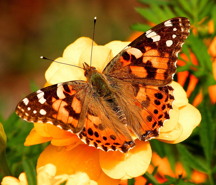
We owe thanks to our pollinators for giving us food to eat and seeds to grow. Bees, birds, bats, moths, flies and butterflies gather protein-rich pollen and sugary nectar from flower to flower while cross-pollinating our food crops and almost every plant we see (except of course those dependent on wind pollination.)
Yet many of our pollinator species are threatened, endangered or extinct from widespread chemical use on farms and gardens, genetically modified crops, and loss of habitat due to development. Bees are considered a “keystone” species, meaning that many other species depend on them for survival. Their extinction means our extinction. So why do we continue to harm them while at the same time demanding so much?
We can begin to help our pollinators by incorporating native plants back into our landscape and creating forage in places where it’s lacking. We can make our gardens a natural habitat for insects rather than a toxic place that only exists for our enjoyment. It’s a critical time to create gardens that mimic the native environment and help our suburbias (and farms!) be a little more natural. Below, we highlight some ways to encourage pollinators to come onto the scene and some of the plants that attract them.
Over millions of years, plants and pollinating insects have evolved together. Certain pollinators favor certain flowers depending on which colors they can see or which shapes their mouthparts fit into. Below we’ve outlined some patterns, but bear in mind it’s only a rough guide—pollinators are not always picky and tend to jump around. Every visit to the garden is an opportunity to observe pollinator habits.
Nectar-rich flowers attract butterflies, which typically
don’t gather pollen, but extract nectar with long
proboscises.
Abelia (Abelia mosanensis)
Butterfly Weed (Asclepias
spp.)
Butterfly Bush (Buddleia spp.)
New Jersey Tea (Ceanothus
americanus)
Echinacea (Echinacea spp.)
Joe Pye Weed (Eupatoreum
spp.)
Blazing Star (Liatris spp.)
Mexican Sunflower (Tithonia
rotundifolia)
The nectar of red tubular (trumpet-shaped) flowers attract
hummingbirds, which see red and have long narrow beaks that fit perfectly
into deep flowers.
Red Buckeye (Aesculus pavia)
Wild Columbine
(Aquilegia canadensis)
Flowering quince (Chaenomeles spp.)
Cardinal
Flower (Lobelia cardinalis)
Bee Balm (Monarda spp.)
Weigela (Weigela
florida)
Umbelliferous (umbrella-shaped) flowers attract beneficial
insects such as parasitic wasps and syrphid flies that have small mouthparts
that fit perfectly in the tiny little flowers. Not only are these insects
good pollinators but also the best ecological pest management
around!
Yarrow (Achillea millefolium)
Dill (Anethum
graveolens)
Angelica (Angelica archangelica)
Lovage (Levisticum
officinale)
Sweet Cicely (Myrrhis odorata)
Parsley (Petroselinum
crispum)
Elderberry (Sambucus spp.)
Viburnums (Viburnum spp.)
Purple and blue flowers are often pollinated by bees, which
see the ultraviolet end of the spectrum.
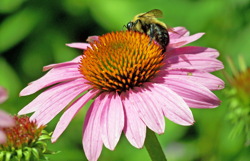
Monkshood (Aconitum carmichaelli)
Blue False Indigo (Baptisia
australis)
Echinacea (Echinacea spp.)
Hyssop (Hyssopus
officinalis)
Lavender (Lavandula spp.)
Catmint (Nepeta
faasenii)
Russian Sage (Perovskia atriplicifolia)
Baikal Skullcap
(Scutellaria baicalensis)
Composite (daisy-shaped) flowers attract many kinds of bees
and also provide a sheltered sleeping place for male bumblebees, which
don’t return to the nest. At dusk or early morning they can be found
tucked under the petals, sleeping soundly upside down.
Arnica (Arnica
chamissonis)
Calendula (Calendula officinale)
Echinacea (Echinacea
spp.)
Gaillardia (Gaillardia spp.)
Sunflower (Helianthus
annuus)
Rudbeckia (Rudbeckia spp.)
Host Plants for Butterfly and Moth Larvae
We often talk
about nectar sources for butterflies and moths, but what about plants that
feed their larvae? Certain host plants are required for the reproduction of
this group of insects, the genus Lepidoptera. Host plants are
always native because they have evolved over thousands of years with the
dependent insects. While butterflies love the nectar of non-native
Buddleia, they will never lay eggs on that plant because it is
inedible to their larvae. Here are some important woody host plants and
trees to incorporate into your landscape:
Maple (Acer spp.)
Birch
(Betula spp.)
Hickory (Carya spp.)
Chestnut (Castanea
spp.)
Hawthorn (Crataegus spp.)
Dogwood (Cornus spp.)
Hazelnut
(Corylus spp.)
Spicebush (Lindera benzoin)
Native Crabapple (Malus
coronarius)
Eastern White Pine (Pinus strobus)
American Plum (Prunus
americana)
Oak (Quercus spp.)
Black Locust (Robinia
pseudoacacia)
Willow (Salix spp.)
Linden (Tilia americana)
Elm
(Ulmus americana)
Blueberry (Vaccinium spp.)
Viburnum (Viburnum spp.)
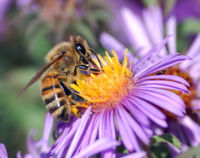
Native Pollinators for the Orchard
Each year it seems
harder and harder to overwinter honeybee hives. While honeybees are not
native to North America, they sure do a good job pollinating our
agricultural food crops. It’s hard to imagine a world without honey!
Though we love them dearly, we must point out that it takes 10,000 or more
honeybees to do the same amount of pollinating as only 250 native mason
bees! Natives fly earlier and later in the day than honeybees and through
wetter and colder conditions. Also, they are more successful pollinators
because they carry pollen all over their bellies instead of in “pollen
baskets” on their hind legs.
Most native bees are solitary dwellers, unlike the social honeybee. They have single nests in holes in wood or in the ground. Two of the best species for pollinating tree fruits are the blue orchard mason bee and the leafcutter bee. One way to encourage native bees is by growing plants that provide early-season forage, like willows, dogwoods, amelanchiers and viburnums. You can also invite bees to the garden or orchard by building simple nest boxes.
Building a wooden block nest box for solitary native
bees
Of course native bees can find their own nesting spots,
but it’s easy to help them by drilling horizontal holes into fence
posts or by making wooden block nest boxes.
Grab a random piece of untreated wood, 4x6'' or so and at least 6'' deep. Drill several holes of different sizes. Smaller bees nest in 3/32–1/4" diameter holes, 3–5'' deep; larger bees need 1/4–3/8'' diameter holes, 5–6'' deep. Holes should be drilled 3/4'' apart and this same distance from the edges. Choose your length. Bees will not nest in holes that have both ends open, so tack a board on the back if holes punch through. They do not like rough holes so make the sides of the holes smooth by using a sharp bit. If you really want to get fancy, you can throw a roof on to help keep off the rain. Mount block nest on a post or attach to a tree trunk near the orchard or garden. Discard nest boxes every few years so they don’t build up with parasites or diseases.
